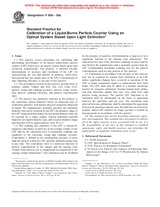Potřebujeme váš souhlas k využití jednotlivých dat, aby se vám mimo jiné mohly ukazovat informace týkající se vašich zájmů. Souhlas udělíte kliknutím na tlačítko „OK“.
ASTM F658-00a
Standard Practice for Calibration of a Liquid-Borne Particle Counter Using an Optical System Based Upon Light Extinction (Includes all amendments And changes 8/16/2017).
Automaticky přeložený název:
Standardní praxe pro kalibraci Liquid - Borne čítač částic pomocí optického systém založený na zeslabení světla
NORMA vydána dne 10.10.2000
Informace o normě:
Označení normy: ASTM F658-00a
Poznámka: NEPLATNÁ
Datum vydání normy: 10.10.2000
Kód zboží: NS-56033
Počet stran: 14
Přibližná hmotnost: 42 g (0.09 liber)
Země: Americká technická norma
Kategorie: Technické normy ASTM
Anotace textu normy ASTM F658-00a :
Keywords:
calibration, light extinction, liquid-borne particles, particle counting, particle size resolution, particle sizing accuracy, sample flow rate, ICS Number Code 17.020 (Metrology and measurement in general)
Doplňující informace
| 1. Scope |
|
1.1 This practice covers procedures for calibrating and determining performance of an optical liquid-borne particle counter (LPC) which uses an optical system based upon light extinction measurement. This practice is directed towards determination of accuracy and resolution of the LPC for characterizing the size and number of particles, which have been passed into the sample inlet of the LPC. Consideration of inlet sampling efficiency is not part of this practice. 1.2 The procedures covered in this practice include those to measure sample volume and flow rate, zero count level, particle sizing and counting accuracy, particle sizing resolution, particle counting efficiency, and particle concentration limit. 1.3 The particle size parameter reported in this practice is the equivalent optical diameter based on projected area of calibration particles with known physical properties dispersed in liquid. The manufacturer normally specifies the minimum diameter that can be reported by an LPC; the dynamic range of the LPC being used determines the maximum diameter that can be reported for a single sample. Typical minimum reported diameters are approximately 2 ´m, and a typical dynamic range specification will be approximately from 50 to 1. 1.4 The counting rate capability of the LPC is limited by temporal coincidence of particles in the sensing volume of the LPC and by the saturation level or maximum counting rate capability of the electronic sizing and counting circuitry. Coincidence is defined as the simultaneous presence of more than one particle within the LPC optically defined sensing zone at any time. The coincidence limit is a statistical function of particle concentration in the sample and the sensing zone volume when particle size is insignificant in comparison to the sensing volume dimensions. This limitation may be modified by the presence of particles with dimension so large as to be a significant fraction of the sensing zone dimension. The saturation level rate of the electronic counting circuitry shall be specified by the manufacturer and is normally greater than the LPC recommended maximum counting rate for the particle concentrations used for any portion of this practice. 1.5 Calibration in accordance with all parts of this practice may not be required for routine field calibration of an LPC unless significant changes have occurred in operation of the LPC or major component repairs or replacements have been made. The LPC shall then be taken to a suitable metrology facility for complete calibration. Normal routine field calibration may determine sample flow rate, zero count level, and particle sizing accuracy. The specific LPC functions to be calibrated shall be determined on the basis of agreement between the purchaser and the user. The maximum time interval between calibrations shall be determined by agreement between the purchaser and the user, but shall not exceed twelve months, unless LPC stability for longer periods is verified by measurements in accordance with this practice. 1.6 This standard may involve hazardous materials, operation, and equipment. This standard does not purport to address all of the safety concerns, if any, associated with its use. It is the responsibility of the user of this standard to establish appropriate safety and health practices and determine the applicability of regulatory limitations prior to use. |




 Cookies
Cookies
